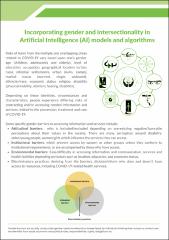Incorporating Gender and Intersectionality In Artificial Intelligence (AI) Models and Algorithms

Tarehe
2022-10Mwandishi
Muyingo, Sylvia
Mbuthia, Michelle
Metadata
Show full item recordUsage Stats
0
views
views
0
downloads
downloads
Kwa ufupi
Risks of harm from the multiple and overlapping crises
related to COVID-19 vary based upon one’s gender,
age (children, adolescents and elderly), level of
education, occupation, geographical location (urban,
rural, informal settlements, urban slums, camps),
marital status (married, single, widowed),
ethnicity/race, economic status, religion, disability
(physical mobility, albinism, hearing. disability).
Depending on these identities, circumstances and
characteristics, people experience differing risks of
contracting and/or accessing needed information and
services related to the prevention, treatment and care
of COVID-19.
Collections
- 2022 [26]
